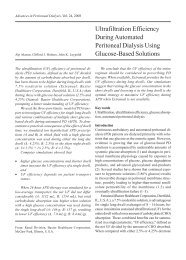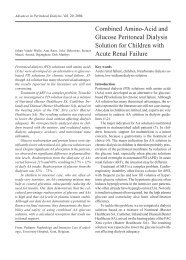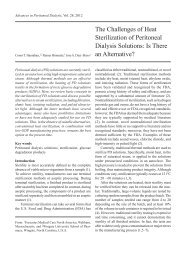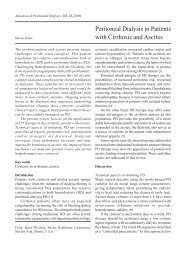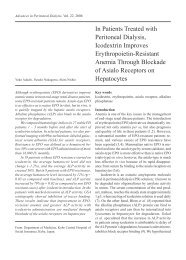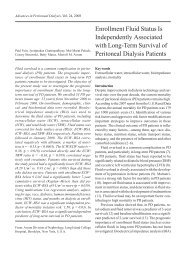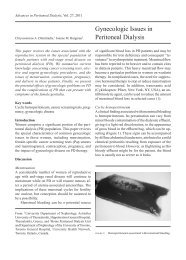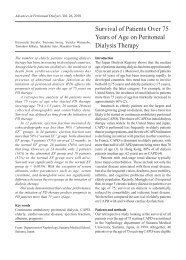The Importance of Residual Renal Function in Peritoneal Dialysis ...
The Importance of Residual Renal Function in Peritoneal Dialysis ...
The Importance of Residual Renal Function in Peritoneal Dialysis ...
You also want an ePaper? Increase the reach of your titles
YUMPU automatically turns print PDFs into web optimized ePapers that Google loves.
Diaz–Buxo et al. 21above and below the reference range. However, thedifference was statistically significant only for patientswith a pKt/V less than 1.45 (p = 0.003). <strong>The</strong>authors concluded that basel<strong>in</strong>e pKt/V was a nonl<strong>in</strong>ear<strong>in</strong>dependent predictor <strong>of</strong> survival <strong>in</strong> <strong>in</strong>cident PDpatients. <strong>The</strong> study had multiple limitations, <strong>in</strong>clud<strong>in</strong>ga retrospective study design, potential confound<strong>in</strong>g bydifferences <strong>in</strong> basel<strong>in</strong>e RRF between the subgroups,and an <strong>in</strong>ability <strong>of</strong> the authors to account for the effects<strong>of</strong> subsequent changes <strong>in</strong> PD dose on the survival<strong>of</strong> participants.An analysis <strong>of</strong> participants on cont<strong>in</strong>uous ambulatoryPD (CAPD) <strong>in</strong> the ADEMEX (Adequacy <strong>of</strong><strong>Dialysis</strong> <strong>in</strong> Mexico) trial—a prospective, randomized,multicenter controlled study—found no benefit<strong>of</strong> <strong>in</strong>creas<strong>in</strong>g peritoneal clearance on survival (12).<strong>The</strong> average pKt/V <strong>of</strong> participants was 1.62 <strong>in</strong> thecontrol group and 2.13 <strong>in</strong> the <strong>in</strong>tervention group.<strong>The</strong> authors speculated that peritoneal clearancesmay have been too high to detect a survival benefit.Another multicenter randomized controlled trial<strong>of</strong> 320 <strong>in</strong>cident CAPD patients <strong>in</strong> Hong Kong (13)showed no differences <strong>in</strong> survival between threegroups <strong>of</strong> patients (target pKt/V: 1.5 – 1.7, 1.7 – 2.0,and >2.0). Despite the lack <strong>of</strong> an effect <strong>of</strong> pKt/V onsurvival, the authors found that the group <strong>of</strong> patientsrandomized to peritoneal clearances rang<strong>in</strong>g from1.5 – 1.7 had more adverse outcomes associated with<strong>in</strong>adequate dialysis.Overall, the data suggest a survival benefit for<strong>in</strong>creas<strong>in</strong>g the pKt/V at clearances below 1.7; however,the effect <strong>of</strong> peritoneal solute removal on survivalappears to plateau at higher levels <strong>of</strong> clearance. <strong>The</strong>f<strong>in</strong>d<strong>in</strong>gs that, <strong>in</strong> contrast to RRF, PD dose does notcontribute to better outcomes was reflected <strong>in</strong> the 2006revision <strong>of</strong> the Kidney Disease Outcomes QualityInitiative recommendation for weekly pKt/V, whichwas reduced to 1.7 from 2.0 (1).Impact <strong>of</strong> peritoneal clearance on survival <strong>in</strong> anuricPD patientsData about the impact <strong>of</strong> peritoneal clearance on survival<strong>in</strong> anuric PD patients are limited. <strong>The</strong> results<strong>of</strong> four observational studies <strong>in</strong> anuric patients areconflict<strong>in</strong>g, but suggest that <strong>in</strong>creas<strong>in</strong>g the peritonealclearance may have a positive impact on survival atpKt/V values up to 1.7 (14–17). <strong>The</strong> studies differedwith respect to sample sizes, trial design, def<strong>in</strong>ition<strong>of</strong> anuria, and selection <strong>of</strong> covariates for analysis.Because most <strong>of</strong> the enrolled participants werereceiv<strong>in</strong>g CAPD, the results may not be directlyapplicable to automated PD (APD) patients.Factors <strong>in</strong>fluenc<strong>in</strong>g RRF decl<strong>in</strong>eNumerous cl<strong>in</strong>ical trials have <strong>in</strong>vestigated the effects<strong>of</strong> various demographic and iatrogenic variables onthe rate <strong>of</strong> RRF decl<strong>in</strong>e. Moist and colleagues (18)conducted an observational cohort study <strong>of</strong> 1843 U.S.dialysis patients to determ<strong>in</strong>e predictors <strong>of</strong> RRF loss<strong>in</strong> <strong>in</strong>cident PD and HD patients. Regression analysis<strong>in</strong>corporated 33 demographic and cl<strong>in</strong>ical variablesthought to <strong>in</strong>fluence the rate <strong>of</strong> RRF decl<strong>in</strong>e. Separateanalyses <strong>of</strong> PD and HD patients were performed toaccount for differences <strong>in</strong> factors that may affect RRFdecl<strong>in</strong>e depend<strong>in</strong>g on modality. Significant <strong>in</strong>dependentpredictors <strong>of</strong> RRF loss <strong>in</strong> PD patients <strong>in</strong>cluded:female sex, non-white race, and history <strong>of</strong> diabetesor congestive heart failure. Patients receiv<strong>in</strong>g angiotens<strong>in</strong>convert<strong>in</strong>g-enzyme <strong>in</strong>hibitors, calcium channelblockers, or PD rather than HD therapy had reducedodds <strong>of</strong> RRF loss. <strong>The</strong> relationship between dialysismodality and risk <strong>of</strong> RRF decl<strong>in</strong>e persisted even afteradjustment for confound<strong>in</strong>g variables <strong>in</strong>clud<strong>in</strong>g age,sex, comorbid conditions, hypertension, medications,and basel<strong>in</strong>e glomerular filtration rate. Interest<strong>in</strong>gly,no difference <strong>in</strong> the risk <strong>of</strong> RRF decl<strong>in</strong>e was observedfor patients receiv<strong>in</strong>g APD or CAPD.Liao and colleagues (9) also conducted a multivariateregression analysis to identify factors that were responsiblefor loss <strong>of</strong> RRF <strong>in</strong> PD patients. Those authorsfound that the median annual rate <strong>of</strong> RRF decl<strong>in</strong>e was0.885 mL/m<strong>in</strong>/1.73 m 2 . Factors that were <strong>in</strong>dependentlyassociated with RRF decl<strong>in</strong>e <strong>in</strong>cluded higher levels<strong>of</strong> basel<strong>in</strong>e RRF, higher body mass <strong>in</strong>dex, history <strong>of</strong>diabetes and congestive heart failure, use <strong>of</strong> diuretics,and history <strong>of</strong> peritonitis and hypotensive events.In accordance with the results reported by Moist andcolleagues, no statistically significant association wasfound between PD modality and rate <strong>of</strong> RRF decl<strong>in</strong>e.Most <strong>of</strong> the available data <strong>in</strong>dicate that preservation<strong>of</strong> RRF and survival are superior for patientsreceiv<strong>in</strong>g PD than for those receiv<strong>in</strong>g HD with<strong>in</strong> thefirst 1 – 2 years <strong>of</strong> therapy (19–22). <strong>The</strong> benefits <strong>of</strong>PD are attributed to better hemodynamic stability anda lack <strong>of</strong> <strong>in</strong>flammatory dialyzer reactions. Althoughmost studies support the conclusion that RRF is betterpreserved <strong>in</strong> PD, a study by McKane and colleagues(23) found that survival was similar between the PD
Diaz–Buxo et al. 237 Termorshuizen F, Korevaar JC, Dekker FW, vanManen JG, Boeschoten EW, Krediet RT on behalf <strong>of</strong>the NECOSAD Study Group. <strong>The</strong> relative importance<strong>of</strong> residual renal function compared with peritonealclearance for patient survival and quality <strong>of</strong> life: ananalysis <strong>of</strong> the Netherlands Cooperative Study on theAdequacy <strong>of</strong> <strong>Dialysis</strong> (NECOSAD)–2. Am J KidneyDis 2003;41:1293–302.8 Rumpsfeld M, McDonald SP, Johnson DW. <strong>Peritoneal</strong>small solute clearance is nonl<strong>in</strong>early related topatient survival <strong>in</strong> the Australian and New Zealandperitoneal dialysis patient populations. Perit Dial Int2009;29:637–46.9 Liao CT, Chen YM, Shiao CC, et al. Rate <strong>of</strong> decl<strong>in</strong>e<strong>of</strong> residual renal function is associated with all-causemortality and technique failure <strong>in</strong> patients on longtermperitoneal dialysis. Nephrol Dial Transplant2009;24:2909–14.10 Park HC, Lee H, Lee JP, et al. Lower residual renalfunction is a risk factor for depression and impairedhealth-related quality <strong>of</strong> life <strong>in</strong> Korean peritonealdialysis patients. J Korean Med Sci 2012;27:64–71.11 Churchill DN, Taylor DW, Keshaviah PR on behalf<strong>of</strong> the CANUSA <strong>Peritoneal</strong> <strong>Dialysis</strong> Study Group.Adequacy <strong>of</strong> dialysis and nutrition <strong>in</strong> cont<strong>in</strong>uous peritonealdialysis: association with cl<strong>in</strong>ical outcomes.Canada–USA (CANUSA) <strong>Peritoneal</strong> <strong>Dialysis</strong> StudyGroup. J Am Soc Nephrol 1996;7:198–207.12 Paniagua R, Amato D, Vonesh E, et al. on behalf <strong>of</strong>the Mexican Nephrology Collaborative Study Group.Effects <strong>of</strong> <strong>in</strong>creased peritoneal clearances on mortalityrates <strong>in</strong> peritoneal dialysis: ADEMEX, a prospective,randomized, controlled trial. J Am Soc Nephrol2002;13:1307–20.13 Lo WK, Ho YW, Li CS, et al. Effect <strong>of</strong> Kt/V on survivaland cl<strong>in</strong>ical outcome <strong>in</strong> CAPD patients <strong>in</strong> a randomizedprospective study. Kidney Int 2003;64:649–56.14 Bhaskaran S, Schaubel DE, Jassal SV, et al. <strong>The</strong> effect<strong>of</strong> small solute clearances on survival <strong>of</strong> anuric peritonealdialysis patients. Perit Dial Int 2000;20:181–7.15 Szeto CC, Wong TY, Chow KM, et al. Impact <strong>of</strong>dialysis adequacy on the mortality and morbidity<strong>of</strong> anuric Ch<strong>in</strong>ese patients receiv<strong>in</strong>g cont<strong>in</strong>uousambulatory peritoneal dialysis. J Am Soc Nephrol2001;12:355–60.16 Jansen MA, Termorshuizen F, Korevaar JC, et al. onbehalf <strong>of</strong> the NECOSAD Study Group. Predictors <strong>of</strong>survival <strong>in</strong> anuric peritoneal dialysis patients. KidneyInt 2005;68:1199–205.17 Lo WK, Lui SL, Chan TM, et al. M<strong>in</strong>imal and optimalperitoneal Kt/V targets: results <strong>of</strong> an anuric peritonealdialysis patient’s survival analysis. Kidney Int2005;67:2032–8.18 Moist LM, Port FK, Orzol SM, et al. Predictors <strong>of</strong> loss<strong>of</strong> residual renal function among new dialysis patients.J Am Soc Nephrol 2000;11:556–64.19 Rottembourg J, Issad B, Gallego JL, et al. Evolution<strong>of</strong> residual renal function <strong>in</strong> patients undergo<strong>in</strong>gma<strong>in</strong>tenance haemodialysis or cont<strong>in</strong>uous ambulatoryperitoneal dialysis. Proc Eur Dial Transplant Assoc1983;19:397–403.20 Lysaght MJ, Vonesh EF, Gotch F, et al. <strong>The</strong> <strong>in</strong>fluence <strong>of</strong>dialysis treatment modality on the decl<strong>in</strong>e <strong>of</strong> rema<strong>in</strong><strong>in</strong>grenal function. ASAIO Trans 1991;37:598–604.21 Misra M, Vonesh E, Van Stone JC, Moore HL, ProwantB, Nolph KD. Effect <strong>of</strong> cause and time <strong>of</strong> dropout onthe residual GFR: a comparative analysis <strong>of</strong> the decl<strong>in</strong>e<strong>of</strong> GFR on dialysis. Kidney Int 2001;59:754–63.22 Lang SM, Bergner A, Töpfer M, Schiffl H. Preservation<strong>of</strong> residual renal function <strong>in</strong> dialysis patients: effects<strong>of</strong> dialysis-technique–related factors. Perit Dial Int2001;21:52–7.23 McKane W, Chandna SM, Tattersall JE, GreenwoodRN, Farr<strong>in</strong>gton K. Identical decl<strong>in</strong>e <strong>of</strong> residual renalfunction <strong>in</strong> high-flux biocompatible hemodialysis andCAPD. Kidney Int 2002;61:256–65.24 Hiroshige K, Yuu K, Soejima M, Takasugi M, KuroiwaA. Rapid decl<strong>in</strong>e <strong>of</strong> residual renal function <strong>in</strong>patients on automated peritoneal dialysis. Perit DialInt 1996;16:307–15.25 Hufnagel G, Michel C, Queffeulou G, Skhiri H, DamieriH, Mignon F. <strong>The</strong> <strong>in</strong>fluence <strong>of</strong> automated peritonealdialysis on the decrease <strong>in</strong> residual renal function.Nephrol Dial Transplant 1999;14:1224–8.26 Rab<strong>in</strong>dranath KS, Adams J, Ali TZ, Daly C, ValeL, Macleod AM. Automated vs cont<strong>in</strong>uous ambulatoryperitoneal dialysis: a systematic review <strong>of</strong> randomizedcontrolled trials. Nephrol Dial Transplant2007;22:2991–8.27 Michels WM, Verduijn M, Grootendorst DC, et al.on behalf <strong>of</strong> the NECOSAD study group. Decl<strong>in</strong>e <strong>in</strong>residual renal function <strong>in</strong> automated compared withcont<strong>in</strong>uous ambulatory peritoneal dialysis. Cl<strong>in</strong> J AmSoc Nephrol 2011;6:537–42.28 Kim SG, Kim S, Hwang YH, et al. on behalf <strong>of</strong> theKorean BalNet Study Group. Could solutions low <strong>in</strong>glucose degradation products preserve residual renalfunction <strong>in</strong> <strong>in</strong>cident peritoneal dialysis patients? A1-year multicenter prospective randomized controlledtrial (BalNet Study). Perit Dial Int 2008;28(suppl3):S117–22.29 Haag–Weber M, Krämer R, Haake R, et al. on behalf <strong>of</strong>the DIUREST Study Group. Low-GDP fluid (Gambrosoltrio) attenuates decl<strong>in</strong>e <strong>of</strong> residual renal function <strong>in</strong>PD patients: a prospective randomized study. NephrolDial Transplant 2010;25:2288–96.



